





The Monks of the Tashi Lhunpo Monastery of Tibet
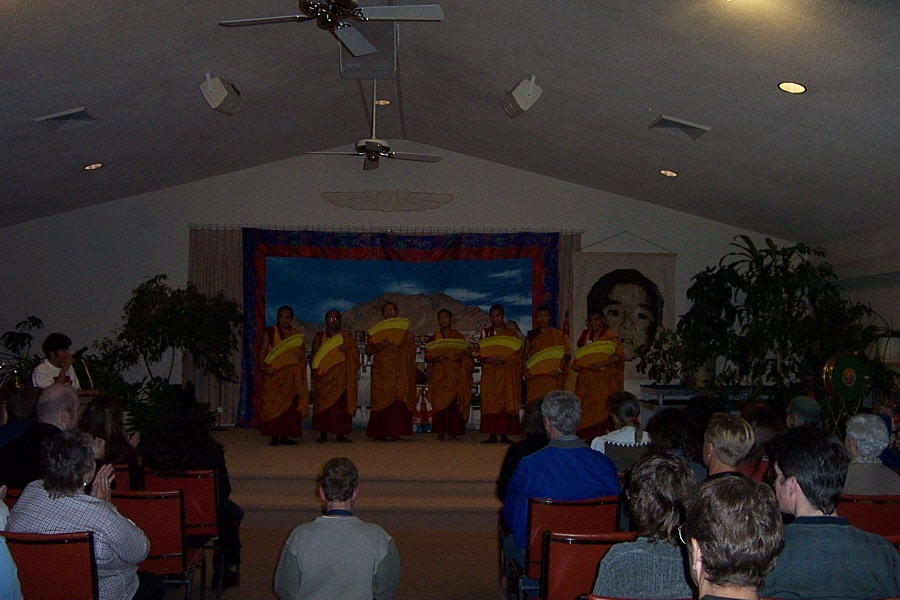
Seven Tibetan monks of the Tashi Lhunpo monastery were in the Roanoke/Blacksburg
area of southwestern Virginia from October 23th through October 28th of 2002.


The Tibetan monks of the Tashi Lhunpo monastery
of Tibet recently toured the USA and Canada to raise money and awareness for the plight
of the Tibetan monks who have been politically oppressed by the current Chinese government.
Erik Olsen, Tom Caruso, Estille Putney, along with myself and many others were instrumental
in staging and coordinating these local events. The monks created an intricate sand mandala
that took 4 days from start to finish at the student center of Virginia Polytechnic
Institute in Blacksburg. I was the promoter for the event staged at the Roanoke Unity Church on
October 25th. This was a successful event and all of us in attendance were blessed with the
presence of these monks who kindly shared a portrayal of their way of monastic practice and
rich Tibetan heritage.
Among some of the things they present is monastic music and dances, chanting, prayer, mudras,
the construction of a sand mandala, and Buddhist doctrine discussion. The performance done at
the Roanoke Unity Church in its entirety is known as the traditional "Cham".

 One of four great monasteries of the Gelugpa school of Tibetan Buddhism, the Tashi Lhunpo
Monastery was founded by His Holiness the 1st Dalai Lama, Je Gendun Drup, in 1447. Je Gendun
Drup also received the name Panchen meaning "great scholar". The successive abbots of Tashi
Lhunpo Monastery were all called "Panchen."
One of four great monasteries of the Gelugpa school of Tibetan Buddhism, the Tashi Lhunpo
Monastery was founded by His Holiness the 1st Dalai Lama, Je Gendun Drup, in 1447. Je Gendun
Drup also received the name Panchen meaning "great scholar". The successive abbots of Tashi
Lhunpo Monastery were all called "Panchen."
The Fifth Dalai Lama announced at his teacher's death that his teacher would reappear as the
Panchen Lama, a recognizable child successor. Since that time it has become convention for the
Dalai Lama and Panchen Lama to be involved in the recognition of each other's successor. Tashi
Lhunpo Monastery has been looked after by the
Panchen Lama. The relationship
between the Dalai Lama and the Panchen Lama has been a principle mechanism of the invading
Chinese to divide the Tibetan people and destroy their religion and culture.
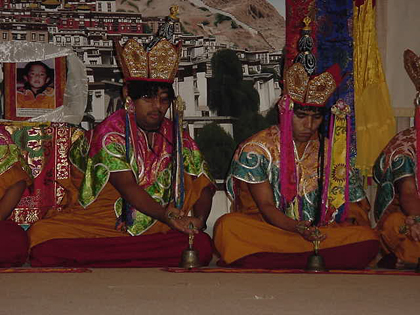 The 10th Panchen Lama was born in 1938 in northeastern Tibet. Almost from the time of his birth, he was caught in the politics of China's ambitions towards Tibet and Tibet's stubborn resistance to the Chinese political game. The Panchen Lama was only eleven in 1949 when the commander of the PLA Lanzhou military division sent a telegram in his name to Mao Zedong, requesting the "liberation of Tibet". In reply, Mao wrote, "The people of Tibet have great love for the motherland. They are opposed to foreign imperialists and willing to join the new united, egalitarian and powerful nation of the PRC."
The 10th Panchen Lama was born in 1938 in northeastern Tibet. Almost from the time of his birth, he was caught in the politics of China's ambitions towards Tibet and Tibet's stubborn resistance to the Chinese political game. The Panchen Lama was only eleven in 1949 when the commander of the PLA Lanzhou military division sent a telegram in his name to Mao Zedong, requesting the "liberation of Tibet". In reply, Mao wrote, "The people of Tibet have great love for the motherland. They are opposed to foreign imperialists and willing to join the new united, egalitarian and powerful nation of the PRC."
In pursuance of its "divide and rule" policy, the communist government of China tried to bring up the Panchen Lama as a rival to His Holiness the Dalai Lama. In 1951 the Panchen Lama was invited to Beijing to coincide with the arrival there of a Tibetan delegation, which was eventually forced to sign the infamous "Seventeen-Point Agreement on Measures for the Peaceful Liberation of Tibet". While in Beijing, the Panchen Lama was forced to send a telegram to the Dalai Lama, stressing the importance of implementing the "Seventeen-Point Agreement under the leadership of the People's Government of China".
The Dalai Lama recognized the Panchen Lama in 1952, when he joined Tashi Lhunpo Monastery. After the flight of the Dalai Lama to India in 1959, the Panchen Lama was appointed acting chairman of the "TAR Preparatory Committee". In 1960 the Chinese appointed him vice-chairman of the National People's Congress, hoping to use him as their puppet spokesman for their policies in Tibet. However, the Panchen Lama remained a steadfast Tibetan nationalist. He was deeply disturbed to find that China had jailed hundreds of thousands of Tibetan government officials, the high lamas and scholars, the community leaders and citizens from many other walks of life. He complained to the Chinese authorities that they were terrorizing the whole populace of Tibet. The Chinese brushed aside his protest by saying that such mistakes were inevitable in all reform movements.
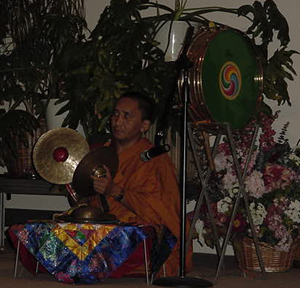 In his capacity as the Vice-chairman of the National People's Congress, the Panchen Lama visited many parts of Tibet. Then, in May 1962 he submitted a 70,000-character petition to Mao Zedong and Zhou Enlai, detailing the atrocities the Chinese army had inflicted on Tibetans. Among other things, the petition pointed out: "After the introduction of reforms, Buddhism has suffered a serious setback and is now on the verge of extinction. ... many prisoners died pitiable deaths when the Dictatorship of the Proletariat was being introduced. This has greatly reduced the population of Tibet over the past few years. ... with the exception of old people, women and children, most of the able-bodied men and intelligent people in the Tibetan areas of Qinghai, Gansu, Sichuan and Yunnan were incarcerated."
In his capacity as the Vice-chairman of the National People's Congress, the Panchen Lama visited many parts of Tibet. Then, in May 1962 he submitted a 70,000-character petition to Mao Zedong and Zhou Enlai, detailing the atrocities the Chinese army had inflicted on Tibetans. Among other things, the petition pointed out: "After the introduction of reforms, Buddhism has suffered a serious setback and is now on the verge of extinction. ... many prisoners died pitiable deaths when the Dictatorship of the Proletariat was being introduced. This has greatly reduced the population of Tibet over the past few years. ... with the exception of old people, women and children, most of the able-bodied men and intelligent people in the Tibetan areas of Qinghai, Gansu, Sichuan and Yunnan were incarcerated."
The Panchen Lama further enraged the Chinese leadership in 1964 when he declared before a huge crowd at Shugtri Linka, his residence in Lhasa, that he considered His Holiness the Dalai Lama as his "refuge for this and the next life". His outspoken comments about Communist Chinese policies in Tibet led to his imprisonment for nearly 10 years during the Cultural Revolution.
In a 20-page wall poster, dated March 3rd, 1979, China's foremost dissident Wei Jingsheng said that life in Qin Cheng prison was so unbearable that the Panchen Lama, among many other inmates, at one time tried to commit suicide. He refused nourishment, declaring that he did not want to go on living. "You can take my body to the Central Committee," Wei quoted him saying.
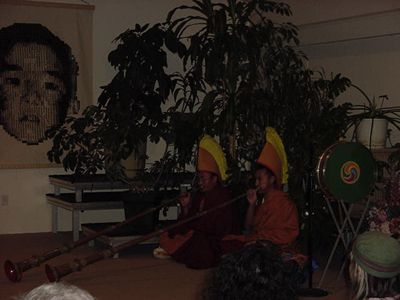 The outside world first came to know about the Panchen Lama's reemergence on February 26th, 1978 when the New China News Agency published a report that he had appeared at the 5th National Committee of the Chinese Political Consultative Conference meeting in plenary session in Beijing. Until then, even Tibetans in Tibet did not know whether the Panchen Lama was alive or dead.
The outside world first came to know about the Panchen Lama's reemergence on February 26th, 1978 when the New China News Agency published a report that he had appeared at the 5th National Committee of the Chinese Political Consultative Conference meeting in plenary session in Beijing. Until then, even Tibetans in Tibet did not know whether the Panchen Lama was alive or dead.
Immediately after his release from prison, the Panchen Lama asked the Chinese authorities for permission to visit Tibet. On reaching Lhasa, he announced: "Tibet is my home and I have a special regard for this land. Although I have not lived here for the last eighteen years, my heart has always been beating with those of the people of Tibet. I have always missed Tibet and its people, and have been thinking about the welfare of Tibetans."
He was to visit Lhasa seven more times before his death, and he also toured various parts of Kham and Amdo. On January 24th, 1989 the Panchen Lama stated in Shigatse - the location of the Tashi Lhunpo Monastery - that Chinese rule in Tibet had brought more destruction than benefit to the Tibetan people. On January 28th 1989, four days after delivering this historic condemnation, the Panchen Lama died, age 51, at the Tashi Lhunpo Monastery. He was one of the most misunderstood lamas in Tibetan culture, and one of the harshest and most courageous critics of Mao's regime.
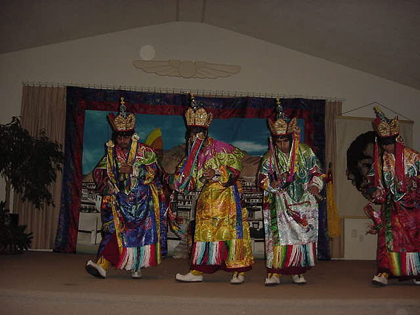 The Dalai Lama informed the Chinese government through its Delhi embassy that he wished to assist in the search for the Panchen Lama's reincarnation by sending a delegation to a sacred lake in Tibet. In June 1991, the Chinese government responded that there was no need for interference.
The Dalai Lama informed the Chinese government through its Delhi embassy that he wished to assist in the search for the Panchen Lama's reincarnation by sending a delegation to a sacred lake in Tibet. In June 1991, the Chinese government responded that there was no need for interference.
The head of the search party as constituted by the Chinese government, Chadral Rinpoche , sent a letter on July 17, 1993 to the Dalai Lama concerning the Panchen Lama reincarnation, along with offerings. He explained that a party had visited two lakes and had received confirmation the Panchen Lama had reincarnated. The Dalai Lama sent a reply on August 5, 1993 to Chadral Rinpoche through the Chinese Embassy in Delhi inviting the delegation to visit India to discuss the search for a reincarnation. There was no response.
On May 14, 1995, after an extensive analysis of over thirty children, four prophecies were consulted from oracles, and nine divinations including the dough-ball ritual were performed, the Dalai Lama formally recognized a six-year-old boy, Gedhun Choekyi Nyima, born on April 25, 1989, in the Lhari District of Nagchu, Tibet, as the 11th Panchen Lama. In Lhasa, all leading figures in the government and religious hierarchy were required to participate in meetings denouncing the Dalai Lama's statement.
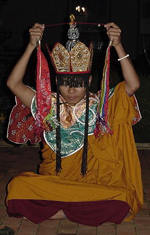
The young Panchen Lama and his family, as well as two other children who were leading candidates, disappeared and were reported to have been relocated to Beijing. The whereabouts of the boy are still unknown.
Shortly after the Dalai Lama fled from Tibet, the Tashi Lhunpo Monastery was re-established in South India under his direction. The Monastery currently has over 250 monks.

 Tashi Lhunpo's first North American tour is endorsed by His Holiness the Dalai Lama. The monks will begin their tour
in Canada and then continue throughout much of the United States. The purpose of the tour is to raise funds for the
monks' meal expenses, to expand overcrowded residence and classrooms, to replace the existing prayer hall, and to
build a paved road from the main road to the monastery.
Tashi Lhunpo's first North American tour is endorsed by His Holiness the Dalai Lama. The monks will begin their tour
in Canada and then continue throughout much of the United States. The purpose of the tour is to raise funds for the
monks' meal expenses, to expand overcrowded residence and classrooms, to replace the existing prayer hall, and to
build a paved road from the main road to the monastery.
Back to the Gaden Jangtse Tibetan monks page:

Jaris' Web Pages:
�2000 by Jaris Dreaming
[email protected]















 One of four great monasteries of the Gelugpa school of Tibetan Buddhism, the Tashi Lhunpo
Monastery was founded by His Holiness the 1st Dalai Lama, Je Gendun Drup, in 1447. Je Gendun
Drup also received the name Panchen meaning "great scholar". The successive abbots of Tashi
Lhunpo Monastery were all called "Panchen."
One of four great monasteries of the Gelugpa school of Tibetan Buddhism, the Tashi Lhunpo
Monastery was founded by His Holiness the 1st Dalai Lama, Je Gendun Drup, in 1447. Je Gendun
Drup also received the name Panchen meaning "great scholar". The successive abbots of Tashi
Lhunpo Monastery were all called "Panchen."  The 10th Panchen Lama was born in 1938 in northeastern Tibet. Almost from the time of his birth, he was caught in the politics of China's ambitions towards Tibet and Tibet's stubborn resistance to the Chinese political game. The Panchen Lama was only eleven in 1949 when the commander of the PLA Lanzhou military division sent a telegram in his name to Mao Zedong, requesting the "liberation of Tibet". In reply, Mao wrote, "The people of Tibet have great love for the motherland. They are opposed to foreign imperialists and willing to join the new united, egalitarian and powerful nation of the PRC."
The 10th Panchen Lama was born in 1938 in northeastern Tibet. Almost from the time of his birth, he was caught in the politics of China's ambitions towards Tibet and Tibet's stubborn resistance to the Chinese political game. The Panchen Lama was only eleven in 1949 when the commander of the PLA Lanzhou military division sent a telegram in his name to Mao Zedong, requesting the "liberation of Tibet". In reply, Mao wrote, "The people of Tibet have great love for the motherland. They are opposed to foreign imperialists and willing to join the new united, egalitarian and powerful nation of the PRC." In his capacity as the Vice-chairman of the National People's Congress, the Panchen Lama visited many parts of Tibet. Then, in May 1962 he submitted a 70,000-character petition to Mao Zedong and Zhou Enlai, detailing the atrocities the Chinese army had inflicted on Tibetans. Among other things, the petition pointed out: "After the introduction of reforms, Buddhism has suffered a serious setback and is now on the verge of extinction. ... many prisoners died pitiable deaths when the Dictatorship of the Proletariat was being introduced. This has greatly reduced the population of Tibet over the past few years. ... with the exception of old people, women and children, most of the able-bodied men and intelligent people in the Tibetan areas of Qinghai, Gansu, Sichuan and Yunnan were incarcerated."
In his capacity as the Vice-chairman of the National People's Congress, the Panchen Lama visited many parts of Tibet. Then, in May 1962 he submitted a 70,000-character petition to Mao Zedong and Zhou Enlai, detailing the atrocities the Chinese army had inflicted on Tibetans. Among other things, the petition pointed out: "After the introduction of reforms, Buddhism has suffered a serious setback and is now on the verge of extinction. ... many prisoners died pitiable deaths when the Dictatorship of the Proletariat was being introduced. This has greatly reduced the population of Tibet over the past few years. ... with the exception of old people, women and children, most of the able-bodied men and intelligent people in the Tibetan areas of Qinghai, Gansu, Sichuan and Yunnan were incarcerated." The outside world first came to know about the Panchen Lama's reemergence on February 26th, 1978 when the New China News Agency published a report that he had appeared at the 5th National Committee of the Chinese Political Consultative Conference meeting in plenary session in Beijing. Until then, even Tibetans in Tibet did not know whether the Panchen Lama was alive or dead.
The outside world first came to know about the Panchen Lama's reemergence on February 26th, 1978 when the New China News Agency published a report that he had appeared at the 5th National Committee of the Chinese Political Consultative Conference meeting in plenary session in Beijing. Until then, even Tibetans in Tibet did not know whether the Panchen Lama was alive or dead. The Dalai Lama informed the Chinese government through its Delhi embassy that he wished to assist in the search for the Panchen Lama's reincarnation by sending a delegation to a sacred lake in Tibet. In June 1991, the Chinese government responded that there was no need for interference.
The Dalai Lama informed the Chinese government through its Delhi embassy that he wished to assist in the search for the Panchen Lama's reincarnation by sending a delegation to a sacred lake in Tibet. In June 1991, the Chinese government responded that there was no need for interference. 

Tashi Lhunpo's first North American tour is endorsed by His Holiness the Dalai Lama. The monks will begin their tour in Canada and then continue throughout much of the United States. The purpose of the tour is to raise funds for the monks' meal expenses, to expand overcrowded residence and classrooms, to replace the existing prayer hall, and to build a paved road from the main road to the monastery.
